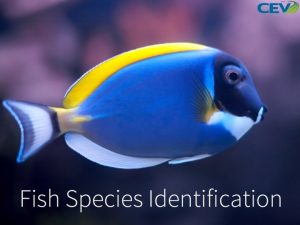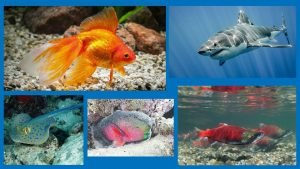Freshwater Fish Species Agriscience 381 2 nd Period



























- Slides: 27

Freshwater Fish Species Agriscience 381 2 nd Period By: Dustin Carnahan

Objectives Students will be able to: 1. Label the external parts of a fish. 2. List and describe five types of freshwater fish found in Texas.

Freshwater fish are those species that live in waters from 0 to 5 (parts per thousand) salt content. This includes rivers, streams, creeks, lakes, ponds, and reservoirs.

Game Fish Species üGame fish are regulated by the Texas Parks and Wildlife Department. üThey are mainly predators even though they may eat vegetation. üMany species have natural hybrids. “They cross and mate between two similar species. ” üIn the case of the Florida largemouth bass and the hybrid striped bass, human involvement was incurred. üRegardless if the species is pure or a hybrid, all game fish have a statewide bag limit and have many length limits.




Freshwater Fish Identification

Bass

Largemouth Bass üWidely distributed in lakes and streams üGreen with dark blotches running down the sides üDorsal fin is almost divided, containing 12 -13 rays. üWhen mouth is closed, the upper jaw extends beyond the posterior of the eye.

Smallmouth Bass ü Golden green sides and back, wavy olive blotches along side ü There are five olive-green bars that radiate back and one radiates forward from each eye. ü Trophy size only reach 3 -4 lbs. ü Feeds on small fish, crustaceans, and large insects, but will also feed on forage. ü Prefer flowing water but, can be found in lakes.

Hybrid Striped Bass üCross between striped bass and white bass. üAdults range from 6 to 60 lbs. üSharp points on tips of gill covers üHas 7 -8 horizontal stripes on sides, referring to the name.


White Bass ü Originally found only in waters of Caddo Lake in far East Texas. ü Has double dorsal fin, front spiny fin is separated from rear softrayed portion. ü Dark gray to black on back and bright silver on sides and white belly. ü Dusky stripes run length of body. ü Adv. size 1 to 1 ½ lbs.

Yellow Bass üGets name from color on belly and sides. üBottom two stripes are broken slightly behind the middle. üTravels in schools. üLikes rocky and gravel bottoms. üFeed on fish, insects, and crustaceans. üLess than 1 pound

Catfish

Channel Catfish üNative to all streams and rivers. üForked tail, distinguishes from all other catfish except (Blue Catfish). üSilvery gray in color, silvery white on belly üSmall black spots found on sides, but they become absent in large adults.

Blue Catfish ü Range in color from slate-blue to grayish brown on their back and sides. ü Forked tail ü Reach up to 300 lbs. ü Big river fish ü Prefer clear fast moving water with hard sand, or gravel bottoms. ü Feeds on shad and other schooling baitfish.


Flathead Catfish

Yellow Bullhead

Crappie

Crappie üWhite Crappie üSilvery green, silver- white belly üVertical bars on sides üDorsal fin has max of 6 spines. üBlack Crappie üBlack blotches üNot statewide, found in East Texas

Trout

Rainbow Trout ü Cold-water species, stocked annually in Texas waters. ü Body shape like a salmon. ü Dark Olive back color, speckled sides, has pink to red stripe along the length of side. ü Carnivores, feed on insects crustaceans, mollusks and fish. ü Live in saltwater but return to rivers to breed. ü Can survive when confined to freshwater.

Walleye üMember of perch family. üLarge eyes, two separate dorsal fins. üCold-water species üDark blotches on a yellow-greenish brown base. üReach 12 -15 lbs. üState Record 25 lbs.

Summary 1. 5 types of freshwater species • Bass, Catfish, Crappie, Trout, Walleye 2. Labeling external fish parts. • Dorsal Fin, Caudal Fin, Anal Fin, Pelvic Fin, Pectoral Fin, Operculum
 One fish two fish red fish blue fish ride
One fish two fish red fish blue fish ride Texas freshwater fish species
Texas freshwater fish species Characteristics of fish
Characteristics of fish One fish two fish blowfish blue fish
One fish two fish blowfish blue fish Saltwater fish in freshwater explode
Saltwater fish in freshwater explode Texas freshwater fish identification
Texas freshwater fish identification Freshwater fish of belize
Freshwater fish of belize Freshwater fish marketing
Freshwater fish marketing A keystone species is a species of plants and animals
A keystone species is a species of plants and animals 381 meaning
381 meaning Pxi-5670
Pxi-5670 Application problem 13-2 accounting
Application problem 13-2 accounting 18 gelecek aylara ait giderler ve gelir tahakkukları
18 gelecek aylara ait giderler ve gelir tahakkukları S 381
S 381 Ee 381
Ee 381 381 meaning
381 meaning Dönem ayirici hesaplar 180 181 280 281 380 381
Dönem ayirici hesaplar 180 181 280 281 380 381 Test of independence
Test of independence 381 meaning
381 meaning Me 381
Me 381 Study guide 12 part two analyzing payroll procedures
Study guide 12 part two analyzing payroll procedures Classical probability examples
Classical probability examples About 41 percent of all fish species inhabit
About 41 percent of all fish species inhabit A big fish swims up and swallows a small fish at rest
A big fish swims up and swallows a small fish at rest Butterfly fish market form
Butterfly fish market form Bony vs cartilaginous fish
Bony vs cartilaginous fish Bony vs cartilaginous fish
Bony vs cartilaginous fish Colorado ag curriculum
Colorado ag curriculum















































